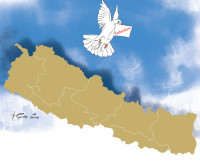Columns
Heated emotions of climate change
The heat in September 2023 broke the record of September 2020 by 0.5 degrees Celsius.
Saumya Pandey
“I have to keep working, I do not have an option. I have to earn my daily wage,” a migrant labourer from the Tarai region of Nepal shared, responding to his extreme working conditions. In parts of Tarai, the thin strip of floodplains that expands into India, the temperature in recent years has been above 40 degrees Celsius. In May and June, a hot dry summer wind, known as the loo in northern parts of India, engulfs this region of the Indo-Gangetic plains. According to the local people in the Tarai, these dry heat waves are getting more intense these days, impacting the lives of migrant workers, farm labourers, sand miners, construction site workers, and tipper truck drivers in ways they cannot avoid or prevent. Yet the daily wage earners say they cannot do much about this: They have no option; they must earn their daily wage.
In 2021, when I was conducting interviews with them, what happened to them in the previous year was very fresh in their memory. The cities in India and Nepal were experiencing unprecedented scales of migration. The migrant labourers were forced out of cities overnight. Cities had closed their borders for work. These measures were undertaken to “contain” the pandemic crisis while there was no mention of the heat crisis that was simultaneously unfolding as September 2020 had been declared the warmest in history. Approximately 104 million migrant workers travelled long distances from urban (work) to rural (home) India in extreme heat. The governments in Nepal and India have no record of migrant worker deaths during this time, making it difficult to assess the gravity of the situation.
As per the record, the heat in September 2023 has broken the record of September 2020 by 0.5 degrees Celsius. 2023 has been declared the hottest year in recorded history. The Copernicus Climate Change Service, implemented by the European Centre for Medium-Range Weather Forecasts, has shared that the average surface air temperature in September 2023 was 16.38 degrees Celsius. This temperature is 0.93 degrees Celsius above September’s 1991-2020 average. In parts of India and Nepal, this temperature is regularly being felt by local people and workers in ways they find hard to define.
Experiences of heat are more than what can be instrumentally measured. Empirically speaking, no monitoring device should be needed to evidence this heat that is so much a part of our daily life. However, the kind of data getting valued on heat is from those with the device to give answers. Practically, therefore, how much effort is required to establish the knowledge base on rising heat is huge, in which one can go on and on to substantiate newer records each year, month, day and hour with no material difference to reality.
In recent years, the measurement of heat that is used the most calculates the thermal temperature and relative humidity levels. A possible approach gaining traction to measuring heat stress is called wet-bulb temperature. This method covers a thermometer in a wet cloth to measure the wet-bulb temperature. As water evaporates from the wet cloth, it cools the thermometer. This mirrors how the human body cools itself with sweat.
There is a chance that the thermal levels of heat have been breached. The highest wet-bulb temperature that humans can survive when exposed to the elements of heat for at least six hours is about 35 degrees Celsius. When wet-bulb temperatures are high, the human body can lose around 80 percent of heat through sweat. The sweat evaporates slowly, making it hard for the body to cool down. If the body finds it hard to cool down, it can be fatal. There is a possibility that the physiological threshold of the heated body is already at stake without much political thought on its implications for those who have to keep working in this economic structure.
Heat is the largest cause of weather-related deaths in the world. In Kathmandu, heat is felt in ways people are not quite used to. It is telling that most old houses in the Kathmandu Valley do not have a ceiling fan. They never needed one. Summers used to be pleasant in the Valley. Yet its presence is increasingly felt these days as the temperature crosses 30 degrees Celsius and the body easily heats up.
In the Nepal-India Tarai region, however, most migrant labourers have shared their experiences of working in extreme heat in daily conversations. Their working conditions in different parts of the world, including Saudi Arabia, northern India, and parts of Nepal, involve long hours of exposure to heat. Their access to drinking water during work hours has also been limited. Although the ways in which this heat is impacting the migrant workers cannot be fully grasped, The Washington Post’s January 2023 article showed that one-third of the kidney transplant patients at a centre in Kathmandu were young men who had worked abroad under extreme heat. It goes without saying that some jobs are currently being carried out under inhuman conditions, but that inhumanity of the economic structure is not part of the political discussion on climate change as these works are considered “essential” and “business as usual.” Yet, this inhumanity is easily missed because most researchers are not trained or prepared to join the dots pertaining to these nontangential heat experiences.
In Calcutta, a city near the Bay of Bengal where most Nepal Himalayan rivers drain, the heat and humidity are so intense these days that people feel their bodies will burst into flames. I have found this description so telling of human physiological as well as psychological conditions: One gets a sense that this heat surpasses human tolerance. In the last three years, I have restricted my questions about heat to people born in the 1960s and 1970s. On several occasions, they have pointed out that almost three decades back during summers, it used to rain every day or every other day in Calcutta in the evenings, which was a source of some respite. “Days used to humid, while nights were moist and wet,” a local Haat market garment seller recalled his experience from the late 1970s. These days, the nights are much hotter and uncomfortable.
To date, heat is South Asia’s most intensely felt emotion of climate change. It cuts across class, but it impacts most of those whose work entails exposure to the environment in extreme ways. Yet this emotion is not spoken about enough. Anthropologist Bharat Venkat, in the context of southern Indian heat conditions, cautions us with his analysis that this tendency to treat everything, including tropical heat, as ‘exceptional’ rather than embedded in the larger history and politics as well as a field researcher’s approach to ‘naturalise’ this heat, is a mark of ignoring its existence. There is nothing ‘exceptional’ or ‘natural’ about heat.
These heated emotions then are not simply a state of climate crisis. They are a state of the ongoing crisis of empathy and imagination. The heat lays bare the existing inequalities of the economy: It informs how we approach the question of climate and the people in it, what we write about, how we write it, and the heated emotions we simply ignore or deny because there is no ‘concrete’ way of knowing them or even talking about them.




 18.12°C Kathmandu
18.12°C Kathmandu

.jpg&w=200&height=120)











%20(1).jpg&w=300&height=200)

